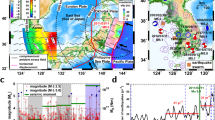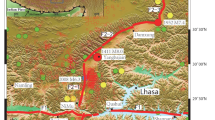Abstract
After the 2008 MW7.9 Wenchuan earthquake, the eastern Tibetan Plateau experienced a series of MW>6.0 earthquakes, including the 2013 MW6.6 Lushan, 2014 MW6.1 Kangding and 2017 MW6.5 Jiuzhaigou events. Based on available constraints, we build a three-dimensional viscoelastic finite element model to calculate Coulomb failure stress caused by these strong earthquakes. In this model, the geometry and slip vector of the initial rupture zone of each earthquake are used to better evaluate the earthquake-related stress projection. Considering reasonable ranges of viscosities for the crust and upper mantle in different tectonic units, numerical results show that after the Wenchuan earthquake, the coseismic Coulomb failure stress change at the hypocenters of the subsequent earthquakes increased to approximately +0.012–+0.040, +0.01–+0.03, and +0.008–+0.015 MPa, respectively. With viscoelastic relaxation of the lower crust and upper mantle, the Coulomb failure stress change at the hypocenters of these earthquakes accumulated to about +0.014–+0.042, +0.016–+0.036, and +0.003–+0.007 MPa just before their occurrence. This suggests that the Wenchuan earthquake indeed triggered or hastened the occurrence of the Lushan, Kangding and Jiuzhaigou events, supporting that strong earthquake clustering around the eastern Tibetan Plateau could be related to stress interaction between the seismogenic faults. Besides, ~94% and ~6% of the stress increase around (and before the occurrence of) the Kangding earthquake were contributed by the Wenchuan event and the Lushan event, respectively; the positive Coulomb failure stress change at the Jiuzhaigou earthquake hypocenter was related to coseismic slip partitioning of the Wenchuan earthquake. This means that stress interaction among the earthquakes could be controlled by the combined effect of stress of the previous events and by the complexity of earthquake ruptures. Thus, in researches on the earthquake-triggering mechanism, special attentions should be paid on both details of the rupture model and multiple factors of previous earthquakes.
Similar content being viewed by others
References
Chen Y, Niu F, Liu R, Huang Z, Tkalčić H, Sun L, Chan W. 2010. Crustal structure beneath China from receiver function analysis. J Geophys Res, 115: B03307
Chen Y T, Yang Z X, Zhang Y, Liu C. 2013. From 2008 Wenchuan earthquake to 2013 Lushan earthquake (in Chinese). Sci Sin Terr, 43: 1064–1072
Deng Q D, Zhang P Z, Ran Y K, Yang X P, Min W, Chen L C. 2003. Active tectonics and earthquake activities in China (in Chinese). Earth Sci Front, 10: 66–73
England P C, Walker R T, Fu B, Floyd M A. 2013. A bound on the viscosity of the Tibetan crust from the horizontality of palaeolake shorelines. Earth Planet Sci Lett, 375: 44–56
Freed A M, Lin J. 2001. Delayed triggering of the 1999 Hector Mine earthquake by viscoelastic stress transfer. Nature, 411: 180–183
Harris R A. 1998. Introduction to special section: Stress triggers, stress shadows, and implications for seismic hazard. J Geophys Res, 103: 24347–24358
Huang M H, Bürgmann R, Freed A M. 2014. Probing the lithospheric rheology across the eastern margin of the Tibetan Plateau. Earth Planet Sci Lett, 396: 88–96
Huang L Y, Cheng H H, Zhang H, Gao R, Shi Y L. 2019. Coseismic and postseismic stress evolution caused by the 2008 Wenchuan earthquake and its effects on the 2017 MS7.0 Jiuzhaigou earthquake (in Chinese). Chin J Geophys, 62: 1268–1281
He J, Peltzer G. 2010. Poroelastic triggering in the 9–22 January 2008 Nima-Gaize (Tibet) earthquake sequence. Geology, 38: 907–910
He J, **a W, Lu S, Qian H. 2011. Three-dimensional finite element modeling of stress evolution around the **aojiang fault system in the southeastern Tibetan plateau during the past −500 years. Tectonophysics, 507: 70–85
Jagla E A, Kolton A B. 2010. A mechanism for spatial and temporal earthquake clustering. J Geophys Res, 115: B05312
Jaeger J C, Cook N G W. 1979. Fundamentals of Rock Mechanics. 3rd ed. London: Chapman and Hall
Jia K, Zhou S, Zhuang J, Jiang C, Guo Y, Gao Z, Gao S. 2018. Did the 2008 MW7.9 Wenchuan earthquake trigger the occurrence of the 2017 MW6.5 Jiuzhaigou earthquake in Sichuan, China? J Geophys Res-Solid Earth, 123: 2965–2983
King G C P, Stein R S, Lin J. 1994. Static stress changes and he triggering of earthquakes. Bull Seismol Soc Amer, 84: 935–953
Liu G, **ong W, Wang Q, Qiao X, Ding K, Li X, Yang S M. 2019. Source Characteristics of the 2017 MS7.0 Jiuzhaigou, China, Earthquake and Implications for Recent Seismicity in Eastern Tibet. J Geophys Res- Solid Earth, 124: 4895–4915
Li Q, Liu M, Zhang H. 2009. A 3-D viscoelastoplastic model for simulating long-term slip on non-planar faults. Geophys J Int, 176: 293–306
Liang G. 2010. The Finite Element Language. Bei**g: Science Publication House
Lin J, Stein R S. 2004. Stress triggering in thrust and subduction earthquakes and stress interaction between the southern San Andreas and nearby thrust and strike-slip faults. J Geophys Res, 109: B02303
Melosh H J, Raefsky A. 1981. A simple and efficient method for introducing faults into finite element computations. Bull Seismol Soc Amer, 71: 1391–1400
Molnar P, Chen W P. 1983. Focal depths and fault plane solutions of earthquakes under the Tibetan plateau. J Geophys Res, 88: 1180–1196
Parsons T, Ji C, Kirby E. 2008. Stress changes from the 2008 Wenchuan earthquake and increased hazard in the Sichuan basin. Nature, 454: 509–510
Pang Y J, Cheng H H, Zhang H, Shi Y L. 2017. Numerical modeling of crustal deformation in the eastern margin of the Bayan Har block and analysis of seismogenic environment of the 2017 Jiuzhaigou earthquake (in Chinese). Chin J Geophys, 10: 4046–4055
Rice J R. 1992. Fault stress states, pore pressure distributions, and the weakness of the San Andreas Fault. In: Hickman S, ed. Fault Mechanics and Transport Properties of Rocks: A Festschrift in Honor of W. F. Brace. London: Academic Press. 475–503
Rice J R, Cleary M P. 1976. Some basic stress diffusion solutions for fluidsaturated elastic porous media with compressible constituents. Rev Geophys, 14: 227
Royden L H, Burchfiel B C, King R W, Wang E, Chen Z, Shen F, Liu Y. 1997. Surface deformation and lower crustal flow in eastern Tibet. Science, 276: 788–790
Shan B, **ong X, Zheng Y, Diao F Q. 2009. Stress changes on major faults caused by MW7.9 Wenchuan earthquake, May 12, 2008. Sci China Ser D-Earth Sci, 52: 593–601
Shan B, **ong X, Zheng Y, ** B K, Liu C L, **e Z J, Hsu H T. 2013. Stress changes on major faults caused by 2013 Lushan earthquake and its relationship with 2008 Wenchuan earthquake. Sci China Earth Sci, 56: 1169–1176
Shan B, Zheng Y, Liu C L, **e Z J, Kong J. 2017. Coseismic Coulomb failure stress changes caused by the 2017 M7.0 Jiuzhaigou earthquake, and its relationship with the 2008 Wenchuan earthquake. Sci China Earth Sci, 60: 2181–2189
Shao Z G, Fu R S, Xu T X, Huang J F. 2008. The numerical simulation and discussion on mechanism of postseismic deformation after Kunlun MS8.1 earthquake (in Chinses). Chin J Geophys, 51: 805–816
Shen Z K, Lü J, Wang M, Bürgmann R. 2005. Contemporary crustal deformation around the southeast borderland of the Tibetan Plateau. J Geophys Res, 110: B11409
Shen Z K, Sun J, Zhang P, Wan Y, Wang M, Bürgmann R, Zeng Y, Gan W, Liao H, Wang Q. 2009. Slip maxima at fault junctions and rupturing of barriers during the 2008 Wenchuan earthquake. Nat Geosci, 2: 718–724
Stein R S. 1999. The role of stress transfer in earthquake occurrence. Nature, 402: 605–609
Wang W M, Zhao L F, Li J, Yao Z X. 2008. Rupture process of the MS8.0 Wenchuan earthquake of Sichuan, China (in Chinese). Chin J Geophys, 51: 1403–1410
Wang W M, Hao J L, Yao Z X. 2013. Preliminary result for rupture process of Apr. 20, 2013, Lushan earthquake, Sichuan, China (in Chinese). Chin J Geophys, 56: 1412–1417
Wang Q, Qiao X J, Lan Q G, Freymueller J, Yang S M, Xu C J, Yang Y L, You X Z, Tan K, Chen G. 2011. Rupture of deep faults in the 2008 Wenchuan earthquake and uplift of the Longmen Shan. Nat Geosci, 4: 634–640
Wang J, Xu C, Freymueller J T, Li Z, Shen W. 2014. Sensitivity of Coulomb stress change to the parameters of the Coulomb failure model: A case study using the 2008 MW7.9 Wenchuan earthquake. J Geophys Res-Solid Earth, 119: 3371–3392
Wang J J, Xu C J. 2017. Coseismic Coulomb stress changes associated with the 2017 MW6.5 Jiuzhaigou earthquake (China) and its impacts on surrounding major faults (in Chinese). Chin J Geophys, 60: 4398–4420
Wei X, Wang X T, Li Z W, Wang S F, Huang Z B, Liu J. 2019. Initial rupture depth of the 8 August 2017 M7.0 Jiuzhaigou earthquake derived from Pn/Pg relative location (in Chinese). Chin J Geophys, 62: 1300–1311
Wessel P, Smith W H F. 1991. Free software helps map and display data. Eos Trans AGU, 72: 441–446
Williams C A, Richardson R M. 1991. A rheologically layered three-dimensional model of the San Andreas fault in central and southern California. J Geophys Res, 96: 16597–16623
**e X, Yao Z. 1989. A generalized reflection transmission coefficient matrix method to calculate static displacement field of a dislocation source in a stratified half-space (in Chinese). Chin J Geophys, 32: 270–280
**ong X, Shan B, Zheng Y, Wang R. 2010. Stress transfer and its implication for earthquake hazard on the Kunlun Fault, Tibet. Tectonophysics, 482: 216–225
Xu J, Shao Z G, Liu J, Ji L Y. 2017. Analysis of interaction between great earthquakes in the eastern Bayan Har block based on changes of Coulomb stress (in Chinese). Chin J Geophys, 60: 4056–4068
Xu X, Wen X, Yu G, Chen G, Klinger Y, Hubbard J, Shaw J. 2009. Coseismic reverse- and oblique-slip surface faulting generated by the 2008 MW7.9 Wenchuan earthquake, China. Geology, 37: 515–518
Yao Z, Ji C. 1997. The inverse problem of finite fault study in time domain (in Chinese). Chin J Geophys, 40: 691–701
Zhan Z, ** B, Wei S, Graves R W. 2011. Coulomb stress change sensitivity due to variability in mainshock source models and receiving fault parameters: A case study of the 2010–2011 Christchurch, New Zealand, earthquakes. Seismol Res Lett, 82: 800–814
Zhang Z, Wang Y, Chen Y, Houseman G A, Tian X, Wang E, Teng J. 2009. Crustal structure across Longmenshan fault belt from passive source seismic profiling. Geophys Res Lett, 36: L17310
Zhang P Z, Wen X, Shen Z K, Chen J. 2010. Oblique, high-angle, listricreverse faulting and associated development of strain: The Wenchuan earthquake of May 12, 2008, Sichuan, China. Annu Rev Earth Planet Sci, 38: 353–382
Zhang C J, Cao J L, Shi Y L. 2009. Studying the viscosity of lower crust of Qinghai-Tibet Plateau according to post-seismic deformation. Sci China Ser D-Earth Sci, 52: 411–419
Zhu S B, Miao M. 2016. On the study of earthquake triggering: Solution to paradox that Coulomb stress increase with frictional coefficients (in Chinese). Chin J Geophys, 59: 169–173
Acknowledgements
We thank three anonymous reviewers for their helpful comments. Some figures were plotted by using the GMT software (Wessel and Smith, 1998). This work was supported by the Strategic Priority Research Program of the Chinese Academy of Sciences (Grant No. XDA20070302), the National Natural Science Foundation of China (Grant Nos. 41674104 & 41274064) and the 13th Five-year Informatization Plan of Chinese Academy of Sciences (Grant No. XXH13505–06).
Author information
Authors and Affiliations
Corresponding author
Rights and permissions
About this article
Cite this article
Xu, D., **ao, J., He, J. et al. Strong earthquake clustering around the eastern Tibetan Plateau after the 2008 MW7.9 Wenchuan earthquake. Sci. China Earth Sci. 63, 999–1012 (2020). https://doi.org/10.1007/s11430-019-9581-x
Received:
Revised:
Accepted:
Published:
Issue Date:
DOI: https://doi.org/10.1007/s11430-019-9581-x




